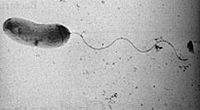Vibrio cholerae: Difference between revisions
imported>Zerla Lau |
imported>Zerla Lau |
||
| Line 20: | Line 20: | ||
[[Image:767px-Cholera_bacteria_SEM.jpg|300 px]] | [[Image:767px-Cholera_bacteria_SEM.jpg|300 px]] | ||
''Vibrio Cholerae'' is a [[gram-negative]], curved rod-shaped [[bacterium]] that has a single polar [[flagellum]]. It is an [[aerobic]] organism and thrives best in [[alkaline]] mediums. | ''Vibrio Cholerae'' is a [[gram-negative]], curved rod-shaped [[bacterium]] that has a single polar [[flagellum]]. It is an [[aerobic]] organism and thrives best in [[alkaline]] mediums.<ref>http://en.wikipedia.org/wiki/Vibrio_cholerae</ref> | ||
==Genome structure== | ==Genome structure== | ||
Revision as of 15:05, 16 April 2008
Articles that lack this notice, including many Eduzendium ones, welcome your collaboration! |
 | ||||||||||||||
| Scientific classification | ||||||||||||||
| ||||||||||||||
| Binomial name | ||||||||||||||
| Vibrio cholerae |
Description and significance
Vibrio Cholerae is a gram-negative, curved rod-shaped bacterium that has a single polar flagellum. It is an aerobic organism and thrives best in alkaline mediums.[1]
Genome structure
The Cholera genome sequencing started in 1997 and was completed several years ago which revealed the bacterium`s two circular chromosomes with the larger of the chromosome having approximately 3 million base pairs. The smaller of the pair chromosomes have approximately one million. Of the total 3,885 genes of Vibrio cholerae, approximately 75% of those genes reside on the larger chromosome. Obtaining this extra chromosome gives a competitive advantage for the survival of V. cholerae in diverse environments.
According to the authors Kaper et. al at the University of Maryland School of Medicine, Vibrio cholerae`s familial species seized a large plasmid and over time the two organisms exchanged genes and genetic information and relied on each other for survival.
Cell structure and metabolism
Describe any interesting features and/or cell structures; how it gains energy; what important molecules it produces.
Ecology
Vibrio cholerae resides in aquatic habitats and are able to thrive in both fresh water and marine environments. In fresh water environments, the bacteria will inhabit lakes, ponds, and rivers. Marine environments such as oceans and seas are also places where V. cholerae can be found.
V. cholerae are also readily found in costal areas where there are significant amounts of algal bloom. Overabundance of algal blooms such as phytoplankton and zooplankton have tremendous consequences on food and water safety because Vibrio cholerae attaches itself to small marine crustaceans called Copepods which help spread Cholera.
Pathology
Vibrio cholerae was first isolated by an Italian scientist, Filippo Pacini, after the Asiatic Cholera Pandemic of 1846- 63 swept through Italy. Pacini accurately described the disease an acute loss of fluid and electrolytes caused by the bacteria acting on the epithelial intestinal mucuosa. However, despite having published numerous publications on his research and dicoveries, his scientific work was rejected and ignored by the community due to the prevailing Miasma Theory of Disease which scientists thought was the valid explanation for the cause of Cholera. Thirty years later in 1884,a German physician Robert Koch, who was one of the founders of Microbiology became the acknowledged discoverer of V. cholerae. Koch was oblivious to the research done by Pacini and since Koch was well regarded in the scientic community, he became of the acknowleged discoverer of V. cholerae.
Vibrio cholerae is the causative agent of a serious epidemic disease Cholera. Cholera is a harmful bacterial ailment that often causes severe diarrhea which is usually procurred by the ingestion of food or water contaminated with V. cholerae. In epidemics, Cholera is transmitted by contamination of water with infected feces due to inadequate santitation.
When ingested, Vibrio cholerae adapts itself to colonize in the human intestinal tract, mainly the small intestine. It then attaches to the mucosal surface which the Vibrio cholerae would produce an enterotoxin, the cholera toxin or CTFX. The cholera toxin has an A Subunit attached to a B subunit. The A subunit consists of an A1 domain that contains the enzymatic active site and an A2 domain that has an helical tail. The B Subunit has 5 identical peptides that assemble into a pentameric ring surrounding a central pore.
When the toxin is released from the bacteria in the infected intestine, it binds to enterocytes through the interaction of the B subunit with the GM1 ganglioside receptor on the intestinal cell which will then trigger endocytosis of the toxin. The A/B complex then undergoes cleavage to become an active enzyme and enters the cytosol where it activates the G protein Gsa to lock the protein in its GTP- bound form causing continual stimulation of ]]adenylate cyclase]] to produce cAMP. High cAMP levels activate the Cystic Fibrosis Transmembrane Conductor Regulator. This causes a massive efflux of ions and water from infected enterocytes and results in copious amounts of watery diarrhea. If left untreated, death may ensue within a matter of hours.
Since the advancement of modern sewages and water treatment facilities, Cholera have been reduced tremendously in industrialized countries. However, Cholera is still substantially present in other parts of the world such as Asia, the Middle East, Latin America, and Sub-Saharan Africa. Social and environmental factors in these areas such as poverty, war, or natural disasters foster cholera outbreaks because people are forced to live in congested conditions with poor and insufficient sanitation.
Application to Biotechnology
Does this organism produce any useful compounds or enzymes? What are they and how are they used?
Current Research
Enter summaries of the most recent research here--at least three required
